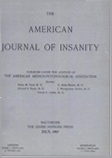ONE HUNDRED SCHIZOPHRENIC CASES OF LATE HOSPITALIZATION
Abstract
Schizophrenic cases of late onset or late hospitalization were collected up to the number 100, each patient being over forty-five when first admitted to a mental hospital. Thirty patients were upwards of fifty years when mental symptoms were first observed.
Although there was no selection of cases with reference to sex, the group includes 85 females and only 15 males.
Classification according to type shows 66 cases of the paranoid form, 24 of the catatonic form, and 10 cases of "other types."
Most of the patients had been self-supporting up to the depression years. Including married women who took care of their homes, satisfactory occupational adjustment can be claimed for 81 persons. Only nine were wholly dependent.
The group includes 47 unmarried persons, about three times as heavy a proportion of single persons as the 1930 census shows for the Massachusetts population of approximately the same age. Among the married persons of the group, seventy per cent made satisfactory marital adjustment up to the onset of the psychosis.
Most of the patients were in relatively good physical health. Less than half of them appear to have shown definitely schizoid trends prior to the onset of psychosis, but it is observed that none occupied a position of leadership in the community.
Regression of extreme degree is noted in only a few cases. Forty of the patients have been returned to the community and were doing well when last heard from. Among the 37 patients who are still in the hospital, 20 are good institutional workers and are in condition to have parole privileges for a considerable part of the time.
Access content
To read the fulltext, please use one of the options below to sign in or purchase access.- Personal login
- Institutional Login
- Sign in via OpenAthens
- Register for access
-
Please login/register if you wish to pair your device and check access availability.
Not a subscriber?
PsychiatryOnline subscription options offer access to the DSM-5 library, books, journals, CME, and patient resources. This all-in-one virtual library provides psychiatrists and mental health professionals with key resources for diagnosis, treatment, research, and professional development.
Need more help? PsychiatryOnline Customer Service may be reached by emailing [email protected] or by calling 800-368-5777 (in the U.S.) or 703-907-7322 (outside the U.S.).



